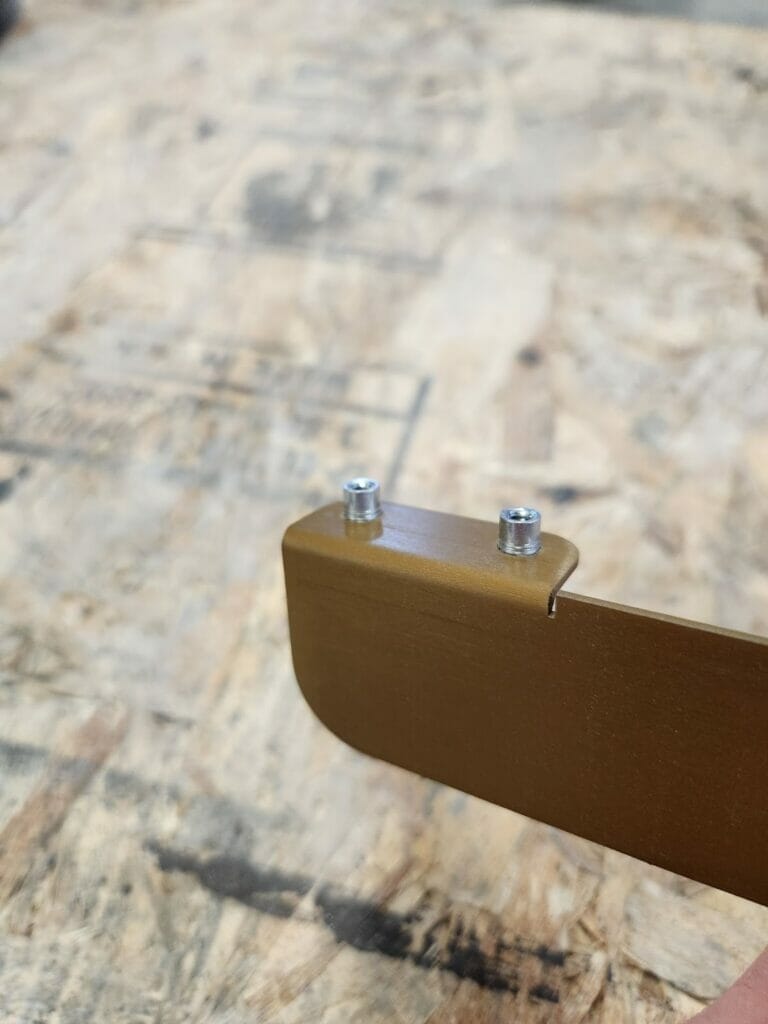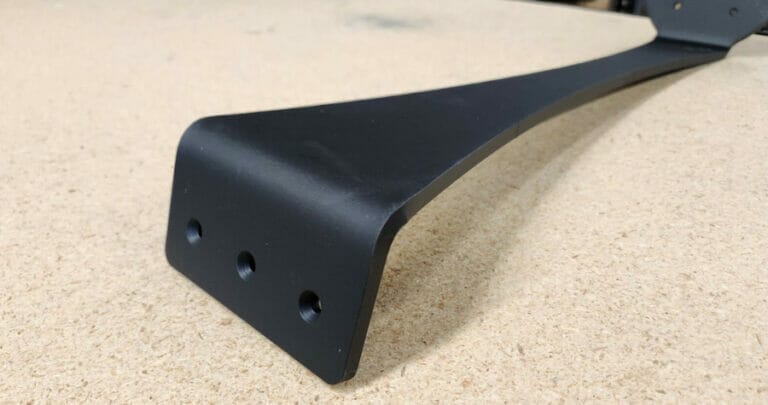At SendCutSend we offer several aluminum alloys, and our 5052 H32 Aluminum is one of our most commonly used materials. In this article we cover some of the specifics of this popular aluminum alloy: What makes it so useful in a wide range of applications, what it is good for, and whether this material is the best choice for your laser cutting project.
What is 5052 Aluminum?
When compared to most common industrial materials, aluminum is new to the party; having only become commercially available around the turn of the 20th century. But, due to its outstanding strength-to-weight ratio (aluminum is 2.5 to 3 times less dense than steel), high fatigue strength and corrosion resistance, low cost, and mechanical properties ideal for both bending and machining, 5052 is easily one of our most ordered metals for any project, whether that’s in the air, on the water, or someplace in between.
Specifications
Although typically known by its Aluminum Association (AA Inc.) 4-digit grade of 5052, other international designations include UNS A95052 and ISO AlMg2.5. As the number implies, 5052 is part of the 5xxx series which are all alloyed with about 2.5% magnesium. 5052 also includes up to 0.35% chromium and smaller percentages of iron (Fe), silicon (Si), manganese (Mn), zinc (Zn), and copper (Cu).
Because of its chemical composition it is a non-heat treatable alloy, meaning it is cold work hardened, which is where the H32 designation comes into play. This simply means that 5052 H32 has been work hardened by rolling, then stabilized using a low-temperature heat treatment process to about one-quarter hardness. This allows 5052-H32 to be very workable, or malleable (not brittle). Because of the formation of aluminum oxide on its surface, and only trace copper content, 5052 exhibits nearly best-in-class corrosion resistance.
Appearance
Although we cut your 5052 from a sheet of cold rolled, mill finish aluminum, the SendCutSend app is smart enough to automatically add deburring on everything other than our thinnest, 0.040” sheet at no extra cost.

You can also un-select the deburring service if you plan to polish your parts later. Note that bend marks will be visible in the final part, since bending is done after deburring the flat sheet.

How SendCutSend Laser Cuts 5052
We use fiber lasers on 5052 and SendCutSend makes cuts with an accuracy tolerance of +/-0.005” or better. Fiber lasers also have the narrowest kerf of any of our cutting equipment, typically running under 0.01”, meaning that even in a ½” plate, it’s possible to cut holes as small as 0.170” diameter without burn-through in the surrounding material.

Reference the 5052 Material Page for a breakdown by thickness of hole, bridge, and edge size.
Worried about calculating for kerf width? Don’t be, when you upload to our app it compensates for the kerf, so you can spend your time coming up with your next great part design.
What SendCutSend Services are Available for 5052 Aluminum?
Our widest range of value-added services are available for 5052. In addition to laser cutting 5052 in 10 different thicknesses from 0.040” up to ½” plate, we offer:
- Deburring: All but the thinnest sheet are deburred automatically when you order a part. You can choose to not have your parts deburred if you prefer.
- Bending: 5052 up to ¼” thick can be bent. With a 44” x 30” or greater part size.
- Countersinking: Any 5052 thickness greater than 0.100”
- Tapping: If you’ve ever cross threaded a hole, or power tapped aluminum and immediately stripped out the threads, you know it can be frustrating to tap aluminum. Never fear, our machines tap any sheet thicker than 0.040” right every time. Or we will remake the part.
- Hardware Insertion: The secret weapon in the aluminum arsenal, ALL thicknesses we offer are available with hardware insertion.
- Anodizing: Available in various bright colors, anodizing looks great and adds another protective barrier in addition to the native aluminum oxide, particularly in the form of wear resistance.
- Powder Coating: Take your pick of white, red, yellow, green, or three different textures of black. This is an incredibly durable finish compared to conventional paint.
5052 Aluminum Alloy Strengths
Cost
At the time of writing this, 5052 is our lowest cost metal when comparing similar thicknesses. This makes it an excellent choice when corrosion resistance is an important factor vs. mild steel for instance, which is also inexpensive but needs a protective barrier.
Light Weight
5052 aluminum’s density is a comparatively featherweight 2.68 g/cm3 which is 60% of the weight of our highest performance (Grade 5) titanium, and only 33% of the density of 304 Stainless. Because of this, it’s often used in transportation industries, whether automotive, seagoing vessels, or aviation.
Corrosion resistance
Specifically in salt water environments, where 304 Stainless can fall prey to pitting under its chromium oxide layer, the aluminum oxide layer on 5052 is nearly impervious to brackish environments. It also excels at resisting corrosion from concentrated nitric acid, ammonia and ammonium hydroxide, so it is often the material of choice in the chemical industry and for chemical transportation tanks.
Weldability
Both MIG and TIG welding produce good results on 5052. One must be careful to ensure that the surface is abraded to remove the oxide layer and the area and shielding gas must be very dry. Filler metals for welding 5052 include 1100, 4043 (most crack tolerant) and 4047. Preheating is also recommended. Because of its thermal conductivity, it is not as prone to warpage as other materials where the heat tends to stay localized and cause uneven thermal expansion.
Machinability
Unlike some of our other metals (looking at you 304 stainless and titanium) using high speeds and deep cuts, along with plenty of lubrication, 5052 responds well to machining with standard HSS machine tools. For the hobbyist who doesn’t own a full-size mill, good quality woodworking equipment like a drill press and sharp tooling can do in a pinch.
Fatigue strength
Fatigue strength is a measure of the maximum stress that the material can withstand for many (typically >107 ) without breaking. Corrosion and many other factors play into this number, but for its density, 5052 has excellent fatigue strength, meaning it handles flexing/vibration (think, airplane wing) well.
Weaknesses
Heat Tolerance
Because pure aluminum has a relatively low metal melting point of about 1200°F none of its alloys handles high-temperature applications. For comparison, mild steel and titanium have melting points of 2600°F and 3000°F respectively. 5052 starts losing strength around 300°F so keep the temperature of your application in mind.
Overall Strength
Although its softness and inability to be heat treated to increase its strength mean it’s quite malleable and less prone to cracking than 6061 or 7075, its strength–tensile and ultimate–are significantly lower than the other two, meaning that when using 5052, thicker material is required for a given design.
Common Uses
Because of its excellent value, corrosion resistance and strength to weight, 5052 is widely utilized in commercial, industrial, chemical, farming and transportation industries. A few applications include, welded tubes such as those for irrigation systems, pressure vessels rated up to about 400°F, desalination units and boats due to its excellent salt resistance, road signs, and general sheet metal due to its excellent ductility.

In the home/office environment, you can find 5052 in many appliances such as freezers and dishwashers. Desks, shelving and other furniture take advantage of its low weight, while siding, and even roofing are often 5052 aluminum because rusting will never be an issue.
Here at SendCutSend we see a lot of aftermarket automotive applications that make use of 5052, such as pedals, or switch plates, and now with hardware insertion, there is no need to worry about riveting or welding in many cases.
Learn more about 5052 Aluminum and the other 165+ materials we offer for laser cutting, waterjet cutting, and CNC routing.





